

Imperial Home Page -> Imperial Registry -> Body styles
Over the years, automobile body styles have been given all kinds of names. Their origin stems from the days of the horse drawn coaches, with modifications as the horseless carriage came of age. A lot of the names also have origins from the regions they were developed in; usually in Europe (i.e. Berlin and Landau - Germany, Sedan - France). In this link, we will see how these names describe a specific body style - and how losely some of them have been used of late by automotive manufacturers.
After the end of World War I, the Society of Automotive Engineers (SAE) developed a standard nomenclature for body styles. Below we will see what these were.
Phaeton |
|
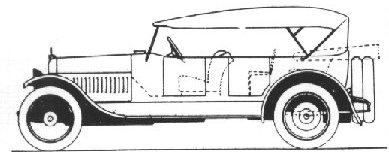 |
The phaeton is an open body with two fixed cross seats for four or five passengers. Sometimes there are folding seats in the tonneau for two additional passengers. The conventional body has four doors with a removable top and side curtains. |
Roadster |
|
| An open type body, having a fixed cross seat for two passengers, and a space or compartment in the rear for luggage. Folding seats fitting into the luggage compartment are sometimes used. The conventional body has two doors, a folding top and removable side curtains. | 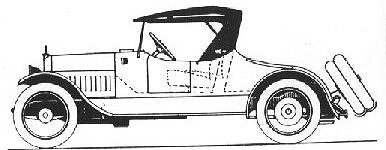 |
Coupé |
|
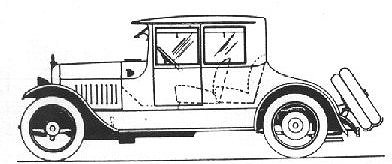 |
The coupé is an enclosed single compartment body with one fixed cross seat. This seat may be straight to accommodate two passengers, or staggered to accommodate three persons. The conventional body has two doors, and two movable glass windows on each side. The roof is permanent, and there is a luggage compartment at the rear. |
Sedan |
|
| The sedan is an enclosed single compartment body with two fixed cross seats for four or five passengers. Folding seats in the tonneau for two additional passengers are sometimes used. The conventional body has four doors, but some models have only two. There are three movable glass windows on each side, and the roof is non-collapsible. | 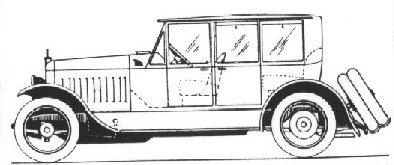 |
Berline |
|
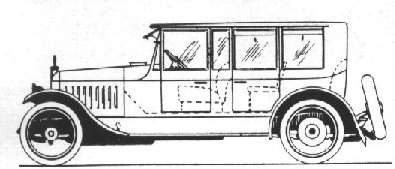 |
A berline is a body along the same description of the Sedan. The exception is that at the rear of the driver's seat, there is an enclosed two compartment body. Generally one glass window in the partition is made so that it can be moved horizontally or vertically. |
Limousine |
|
| A partially enclosed body with a non-collapsible roof that extends the full length, and is attached to the front windshield. Only the partition up to the rear of the driver's seat is enclosed. The rear has a fixed cross seat for two passengers, and folding seats for two additional passengers. There are two doors, and two movable glass windows on each side. | 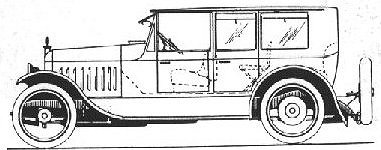 |
Brougham |
|
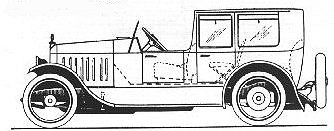 |
A body style similar to the limousine with the exception that the non-collapsible roof extends only over the portion of the body that is entirely enclosed. This body style is also known as the town car. |
Cabriolet |
|
| A body similar to the brougham with the general characteristics of the landaulet (see below). The B pillar is designed to be collapsible or hinged. The roof is designed to be collapsible entirely or in sections - front or rear. All windows including the partition behind the driver's seat are collapsible in the event of top down driving. The rear has a fixed cross seat for two or three passengers, and folding seats for two additional passengers. | 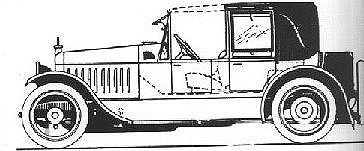 |
Landaulet |
|
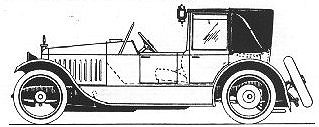 |
A body similar in appearance to the brougham, with the exception that the enclosed section is shorter, and the roof is collapsible up to the partition behind the driver's seat. There is one fixed cross seat for two or three passengers in the back. Only the doors have windows which are movable. Traditionally, the rear quarters are covered in fabric or leather, and outside joints support the roof (a.k.a landau bars). Like the cabriolet, the rear section of this body style is shorter than others, so there is no room for collapsible seats. |
Sedan Landaulet |
|
| A body of the same proportions and description of the sedan, with the exception that the portion of the top behind the doors is collapsible. | 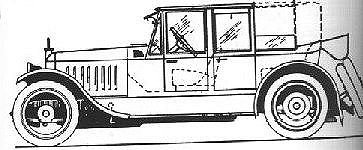 |
Brougham Landaulet |
|
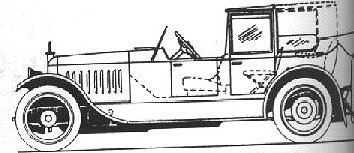 |
A body of the same proportions as the Brougham but with a collapsible roof in the driver's compartment and the rear seat area.
The Munsters' Koach designed by George Barris for the 1960's TV series The Munsters is a Brougham Landaulet body. |
Limousine Landaulet |
|
| The Limousine Landaulet bears the same dimensions as a limousine with the exception of the collapsible roof over the rear seat. | 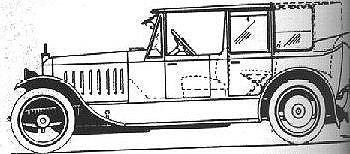 |
Berline Landaulet |
|
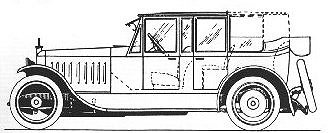 |
The Berline Landaulet has the same resemblance of a Berline body with the exception of the collapsible roof over the rear seat. |
Here is a definition of the various body styles used by Imperials from 1926 through 1993.
2 Door Business Coupe
A single seat coupe. This style was used in the 1937 model year
This style was shorter than a sedan, but with a full rear seat. This style was used in the 1951 and 1952 model years
This style is the standard convertible, and was used for most years that had a convertible. The last 2 Door Convertible was in 1968
This style is a 2 door car with a b pillar that extends from the floor to the roof. There may or may not be a door frame around the window glass. A coupe has less than 33 cubic feet of rear interior volume (more than 33 cubic feet or rear interior volume makes it a sedan). This style was used in many model years
This style was similar to the 2 Door Coupe, but was a custom body by Dietrich. This was only used in the 1929 model year
This style is a 2 door that has the b pillar that only extends to the top of the door, leaving the space from the top of the door to the roof unobstructed from the front to the rear of the car. This style was used in many model years
This style is similar to the 2 Door Convertible, but was a custom body by Lebaron. This was used in the 1932 model year
This style is similar to the 2 Door Convertible, but was a custom body by Lebaron. This was used in the 1931 model year
This style is similar to the 2 Door Coupe, but was a custom body by Lebaron. This was used in the 1931 and 1932 model years
This style is similar to the 2 Door Roadster, but was a custom body by Lebaron. This was used in the 1931 model year
This style is similar to the 2 Door Roadster, but was a custom body by Locke. This was used in the 1929 model year
This style is a 2 door convertible, with a single bench seat, and a luggage compartment in the rear deck. Roadsters, generally has a rumble seat that holds another 1-2 passengers. This style was used throughout the 20s and 30s
This style is similar to the 2 Door Coupe, but a sedan has at least 33 cubic feet of rear interior volume, where as a coupe has less than 33 cubic feet. This style was only used with th 1975 Lebaron
The Touring style is an open style, longer than a phaeton, where the car was open from the top of the door to the roof, with no windows. Later there were detachable side screens and curtains. This style was used in the 1937 model year
This style was used in the 1931 model year
This style is a convertible with 4 door, This style was used in the 30s.
This style has 4 doors, and a b pillar that extends from the floor to the roof. I don't know the differences between the sedan and the deluxe sedan. This style was only used in the 1950 model year
This style is similar to a phaeton, but there are 2 cowls (windshields), one at the front for the driver, and one behind the driver for the passengers. This style was used in the 1931 model year
This style has 4 doors, and the b pillar only extends to the top of the doors, with no door frame around the side windows. This style was used in most years starting in the 1951 model year
This style is similar to the 4 Door Convertible, but was a custom body by Lebaron. This was used in the 1932 model year
This style is similar to the Dual Cowl Phaeton, but was a custom body by Lebaron. This was used in the 1932 model year
This style is a 7 Passenger Limousine with a custom body by Lebaron. This was used in the 1932 model year
This style is similar to the 4 Door Sedan, but was a custom body by Lebaron. This was used in the 1932 model year
This style was intended to be chauffer driven. The limousine style generally had a divider window (or some other means to isolate the passenger area from the driver). In general Limousines are longer than the standard cars all the extra space being used in the rear for the passengers. Limousines are generally for 8 passengers. This style was used in most model year
This style is similar to the limousine, but for 6 passengers
This style is similar to the limousine, but for 7 passengers
This style is similar to the 4 Door Convertible, but with a custom body by Locke. This style was used in 1929
This style is similar to the Phaeton, but with a custom body by Locke. This style was used in 1929
This style is a 4 door convertible with doors, but no door glass, hence from the windshield to the back of the top it is open. This style was used in the 1920s, and sporadically until 1940 the model year
This style is a 4 door, with a b pillar that extends from the floor to the roof. This style generally held 6 passengers, and was used in many years.
This style is similar to a 4 Door Sedan, but held 5 passengers, this style was used in the 1930s
This style is similar to a 4 Door Sedan or a limousine, it held 7 passengers, but there may or may not be a divider between passenger and driver area. this style was used in the 1920s and 1930s
A Laudaulet is a style with an open drivers area, and an enclosed passenger area with one cross seat and (the look of) a collapsible roof (the roof may or may not actually be collapsible). This style was used in 1926
This style is similar to a 4 Door Sedan or a limousine, it held 8 passengers, but there may or may not be a divider between passenger and driver area. this style was used from the 1940s through the 1970s
This style is generally a limousine with an enclosed passenger compartment and an open (or convertible/transformable) driver area, it held 7 passengers
This style is similar to a 4 Door Sedan or a limousine, it held 5 passengers
This style is similar to a 4 Door Sedan or a limousine, it held 6 passengers
This style is similar to a 4 Door Sedan or a limousine, it held 7 passengers
This is just a bare chasis (generally, the frame, running gear, driver train, and maybe the front fenders/grill or the whole front end). These were generally sold to put custom coachwork on.
This is for custom coachwork not defined above
This style was used in the 1954 model year
*** UPDATE 2020 ***
Recently one of our Members, Anthony Platt, sent us his take on the subject of "BODY STYLES"... Thank you Anthony... Please Enjoy...
I decided to accept your invitation and take a stab at the 'primer on body styles'...The styles and terms above were standard right after World War I, and are derived from horse-drawn carriage practice. Several of these styles were found unsuitable for the motor vehicle, and fell out of favor. Some of the names disappeared, while others (particularly 'cabriolet') came to be used for other types.Here is a definition of various body styles used by Imperials from 1926 through 1993. It may not even be possible to make a complete list of types from each individual coachbuilders, as the records of some custom-bodies Imperials have likely been lost to history.From the beginning, custom coachbuilders were involved in building unique Imperials, and other luxury cars. These are properly identified by the addition of the name of the coachbuilder, such as Locke, Detrich, LeBaron, National, Ghia and Stageway, just to name a few. From 1931 to the advent of factory-bodies limousine s just prior to World War II, factory-bodied Imperials were smaller and equipped with smaller eight cylinder engines. Custom Imperials were aptly named during the early part of the 1930s. Not only were their hoods and wheelbases longer and their engines bigger, but they came only with bodies by custom coachbuilders. There were no factory-bodied Custom Imperials during the first half of the 1930s at all. Later, during the era when limousines were built by the factory, the Custom Imperial would be renamed Crown Imperial, and the Custom name would be applied to Imperials on the standard, somewhat shorter wheelbase.A traditional way to describe certain body styles has come into disuse in recent decades, and deserves some explanation, as it is used below. Three window coupes have one window in each door, and a rear window. The windshield (for whatever reason) was never counted. Split rear windows were counted as one. Five window coupes and sedans have two windows per si de and a rear window. Sometimes five window types included rotating vent windows in the rear, and all of these types were liable to include rotating vents in the front doors. These are not counted; only areas of glass between solid, often painted, roof pillars count as 'windows' for this purpose, regardless of whether or not they include combinations of roll-down, swing vent, or fixed pane sections separated by thin, chromed tracks. Seven window models have one window in each of the four doors, one more window per side (normally behind each rear door), and a rear window. Late Crown Imperial Stageway limousines do not fit the traditional seven window pattern, as the additional windows are between the front and rear doors. But they do, nonetheless, have seven windows.Brougham or VictoriaAn early version of the club coupe, a brougham was a two door, five window enclosed body with front and rear bench seats. Victoria was a term unique to Ford (along with Tudor and Ford or) which came into general use. Rear seat legroom was less than the equivalent sedan. Early versions had no built-in trunk, but had room between the rear fenders to mount a trunk rack which did not necessarily hang out over the rear bumper.Business CoupeA two door, two or three seat (single bench seat), enclosed automobile with a sizeable built-in trunk. Differentiated from the standard coupe primarily by the lack of an auxiliary 'rumble seat' in the rear compartment. This was an inexpensive stripper model, and Imperial only offered them in volume in 1937, when Imperial was Chrysler's least expensive eight cylinder. As applied to all brands, they could be three or five window types.CabrioletA convertible coupe, originally differentiated from the Roadster by having roll-up windows and the ability to be made completely weather-tight. Before the mid-1930s, this required the use of coupe doors with full window frames, which made them much less attractive than road sters when both had their tops down. Rumble seats were generally available on cabriolets. The term has since come to be used for any convertible coupe, and was used to describe two door, five seat convertibles in Europe long before that happened in North America.Club CoupeA two door, five window, enclosed body with two bench seats. Essentially a Brougham or Victoria type with a built-in trunk, these lacked the cavernous rear legroom of sedans, but had some of the style, and some of the extra enclosed trunk space of standard coupes. Popular in the 1940s, the demise of the traditional seven window sedan in favor of the close-coupled sedan made the club coupe obsolete--the two door sedan essentially became a club coupe.Convertible CoupeAfter the development of roll-up windows which could seal against folding roofs to make the car weather tight, the convertible coupe became the standard open model, beginning with the finer cars of the mid 1930s and continuing through to the present day. Originally limited in rear seat legroom compared to sedans, like the brougham or club coupe, the rationing of sedan rear legroom in the 1950s brought more parity between the types. In recent years, some carmakers have gotten in the habit of calling the type the Cabriolet. The last Imperial convertible coupe as a standard offering was the 1968 model, though custom coachbuilders did convert a few of the 1981 generation.Convertible SedanA four door open automobile with front and rear seats (and occasionally folding jump seats) which is fully convertible, meaning it has roll-up windows and can be made completely weather tight. Usually with only one windshield. Early models sometimes had full-height B pillars, which could be used to support a second windshield.CoupeA two door, three or five window, enclosed body with, originally, one bench seat inside and, as a common option, a folding rumble seat in the extended baggage compartment. In the 1950 s, cars without rear seats came to be called 'sports cars', and the term 'coupe' came to be applied to convertibles and hardtops. Today anything with two doors is called a coupe (well, unless it's a truck), but that is a relatively recent development.Hardtop CoupeA two door close-coupled sedan with the frameless doors of a convertible coupe and no B pillars supporting the midsection of the roof. Originally and paradoxically called 'hard-top convertibles' because they shared convertible side glass, and resultant simplified styling. But, since they weren't, in fact, convertible to open cars, the term soon got abbreviated. First seen on senior General Motors brands in 1948; Chrysler adopted the type in 1950 with, among other models, the Town and Country. Basically a three-window design with four roll-up window panes.Hardtop sedanA four door with frameless doors and an abbreviated B pillar which is only tall enough to mount door latches and hinges. The dwarf B pill ar does not support the roof. Ford was once of the habit of calling four door sedans with no upper door window frames 'pillared hardtops'. Imperial never offered a 'pillared hardtop', but the full sized Chryslers of 1979-1981 were of that type.LaundauletA Laudaulet is a style with an open driver's area, and an enclosed passenger area with one seat and a collapsible section of the roof behind the rear doors. This style was largely obsolete by the time the Imperial was introduced in 1926, though a few were built that year on Imperial chassis. Raising the roof does make the rear compartment weather tight. Landau irons were almost always used. Some coachbuilders applied the name to fake landaulets, which were sedans, limousines or town cars with the rear quarter windows blanked in favor of leather-covered top sections with fake landau irons.LimousineAn enclosed body with four to eight doors. As a four door luxury limousine, this style was intended to be chauffeur d riven. The luxury limousine has a divider window (or some other means to isolate the passenger area from the driver); this was often the primary difference between the limousine and the seven or eight passenger sedan. In general, limousines are longer than the standard cars, wi th all the extra space being used in the rear for the passengers. Luxury limousines are generally, but not always, for seven or more passengers. Originally the type was similar to seven, and later eight, passenger sedans with folding jump seats, but since most were and are custom-bodied, this varies widely. Sometimes a single jump seat was included, mounted sideways. Later two rear-facing theater seats were used. Now a bench seat which faces the curb side is common, in addition to the standard rear seat. Airport limousines are simply long sedans with one seat row per curbside door (or per pair of doors, depending on the quality of the coachbuilder and the era it was built). Funeral "limousines" were initially seven or eight passenger sedans, but in the 1970s, six door airport limousines came into general use for the purpose. The first limousine of all-steel construction was the 1934 Custom Imperial. This was an extraordinary collaboration between Chrysler and the coach builder LeBaron. The label Town Limousine was occasionally used to differentiate certain Crown Imperials. These included chauffeur-driven sedans with divider windows, and later, full-length Ghia conversions with blank rear quarters.PhaetonLike the touring car, this is a four door open body. Unlike the touring car, the Phaeton was from the first a status symbol, basically a summertime limousine from the era before air conditioned cars. Seven passenger phaetons, with folding jump seats, were available. Phaetons often had a second windshield behind the driver's seat, which served the dual purpose of isolating the driver (as a limousine divider window did), and helping to keep bugs out of the rear seat passengers' teeth. Late in the 1920s, the dual-cowl phaeton was developed. This eliminated the jump seats, but provided an attractive base for the rear windshield to rest on, and moved it closer to the rear passengers' faces for better protection. Some later phaetons h ad roll-up windows, though they still tended not to completely enclose the driver's compartment. The overwhelming majority, however, required side curtains be snapped into place if the weather took an unexpected turn. Phaetons were the ultimate status symbol, not only because they tended to be extraordinarily attractive, but because no one who could afford one used it year 'round. This was a fair weather only auxiliary to an enclosed car.RoadsterToday the term is used to described convertibles with no rear seat, but originally roadsters were not convertible to proper closed cars. Instead, side curtains had to be laboriously snapped into place to keep the rain--or most of it, anyway--out. Built-in cargo areas became a feature at an early date, and rumble seats were a common option.SedanA two door, five window closed body with leg room to rival the standard four door version of the model, or in the years before World War II, a four door, seven window enclosed body with, in the early days, no trunk. By 1951, every American manufacturer but Hudson had either dropped the traditional sedan in favor of the close-coupled sedan, or were building traditional sedans only with long wheelbases, jump seats, and an eight passenger rating, at prices considerably higher than their close-coupled sedans.Close-Coupled, Touring or Town SedanA five window, five or six passenger sedan, generally with proportions approximating a brougham. Early versions usually had room between the rear fenders for a trunk rack ahead of the bumper. By 1951, close-coupled sedans were the norm, though by then the term had fallen out of regular use. During the mid-to-late 1930s, Chrysler used the term touring sedan in several divisions to indicate a standard seven window sedan with a built in, extended trunk.Touring BroughamA two door, open body with front and rear seats. Imperial last used this style in the 1937 model year. Differentiated from convertible coup es by the lack of side windows and the necessity of keeping side curtains on hand.Touring CarA four door, open body with front and rear seats. Like the roadster, it is not a true convertible, and side curtains are used to attempt to keep the weather out.Town CarA limousine with an open driver's compartment. By the mid 1930s, the driver was generally provided with roll-up windows and a removable roof panel. Window counts and passenger capacities varied.ChassisThe bare chassis includes only the frame, running gear, and drive train. The demand for bare luxury car chassis was tiny, though Chrysler sold a special rear-engine bus chassis with the Imperial powerplant in 1929. The more common cowl and chassis was that plus the grille, hood, headlights, two or more fenders, and the cowl. They left the factory with little or no bodywork behind the dashboard. These were generally shipped directly to custom coachbuilders. In later years, when custom coachwork was usua lly limited to hearses and ambulances, additional body panels and/or doors would often be shipped with them. Every Chrysler landaulette, town car, dual-cowl phaeton, or prewar hearse or ambulance you have ever seen left the factory as a cowl and chassis.
If you find any inaccuracies in the above descriptions, or if you have better descriptions for the styles, please contact us so that we can get this information updated. |
This page was last updated July 2020 . Send us your feedback, and join the Imperial Mailing List online car club today!